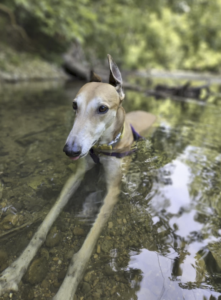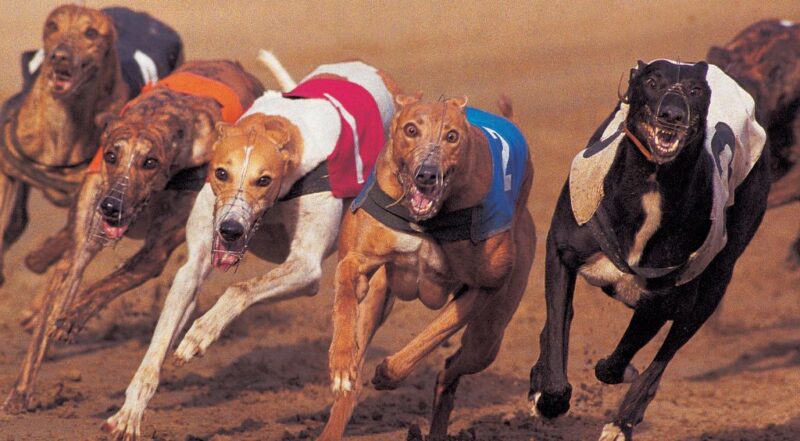by Melinda Quach
Coalition for the Protection of Greyhounds
In Australia, there are some hot weather policies implemented within the greyhound racing industry, however the policies are not consistent across states. CPG’s research shows South Australia’s policy of allowing TAB races to continue despite predicted extreme weather is not seen in most other states. In NSW, Victoria and WA scheduled racing events must be cancelled if the temperature is scheduled to reach 38°C either at any point in the day or at any point during the event’s scheduled time.

UPDATE
Race meetings must be cancelled in the NT if the estimated daily maximum temperature is 40°C. Even in Queensland, where rules on hot weather are also lacking, they at least look at the temperature at the time of the race and base their decision on that, whereas in South Australia it appears they look at the predicted temperature at 8:00am the day of the race. This temperature is irrelevant later on a very hot day. In order to significantly reduce the likelihood of heat illnesses in racing greyhounds, there must be a standard and consistent hot weather policy across the country.
A temperature cap is essential

CPG’s view is that 31°C should be the cut-off point for greyhound racing. At this point, races should be cancelled.
In addition to this, there should also be pre- and post-race cooling exercises implemented to ensure that the greyhound’s temperatures do not reach dangerous levels.
This is particularly important for large dark-coloured greyhounds as they are more susceptible to developing high body temperatures than small light-coloured greyhounds.
SA allows greyhound racing in extreme temperatures
One of the common conditions affecting racing greyhounds are heat illnesses such as heat stress and heat stroke, particularly in countries with high ambient temperatures such as Australia. This is an area of interest for Dr Rebekah Eyers (Animal Welfare Advocate, RSPCA South Australia).
“RSPCA SA has expressed its concerns re dogs racing in extreme temperatures to the SA greyhound racing industry on several occasions. Most importantly, we need mandatory enforceable welfare standards for greyhound racing that include a capped temperature at which races must be cancelled. With climate change predictions to deliver more hot weather events, reform is urgently needed.” she said.
The symptoms to look out for in dogs include panting, dry mucous membranes, prolonged capillary refill time, ataxia and elevated body temperature, all of which can lead to organ failure and ultimately death.
What are the risk factors
An academic research article published in 2016 examined body temperature changes in racing greyhounds across South Australia and the impact of potential risk factors such as sex, body weight and colour. The study produced some surprising results.
-
An Australian study in 2016 of 229 racing greyhounds showed that their core body temperature after racing had equalled or exceeded the critical level of 41.5°C (when the ambient temperature averaged 31.2°C). Given this, 31°C is a maximum threshold for heat stress in racing greyhounds.
-
Greyhound Colour.
The study also found that large dark-coloured greyhounds (i.e. black, blue and brindle) are at greater risk of developing high body temperatures than small light-coloured greyhounds (i.e., fawn and white) when engaging in strenuous exercises in hot temperatures. In order to prevent heat illnesses during and post-race, it is recommended that pre and post exercise cooling be implemented for large dark-coloured greyhounds. -
Sex.
Interestingly, the sex of the greyhound has no significant impact on racing greyhound temperature. The study showed that the average male and female temperature post-race is 41.1 and 40.9 degrees Celsius respectively, so there was no significant difference. -
Cooling Jackets.
Surprisingly, the average rectal temperature post-race of greyhounds that wore cooling jackets were slightly higher than greyhounds that did not wear the jackets. The study further found that trainers often appeared reluctant to use cooling jackets, with the belief that: it would be uncomfortable for the greyhounds; and it would be time-consuming to put on and take off. While the results from the use of cooling jackets were unexpected, the study recommends that other pre and post exercise cooling practices be implemented to reduce heat strain on greyhounds in hot temperatures. -
Body Weight.
The study found a significant but weak relationship between body weight and post-exercise rectal temperatures, as well as between bodyweight and increase in rectal temperature. This is expected as metabolic heat production rises with the amount of energy required to move the body. A heavier greyhound would exert more energy to run, thereby increasing rectal temperatures during and post-race.
